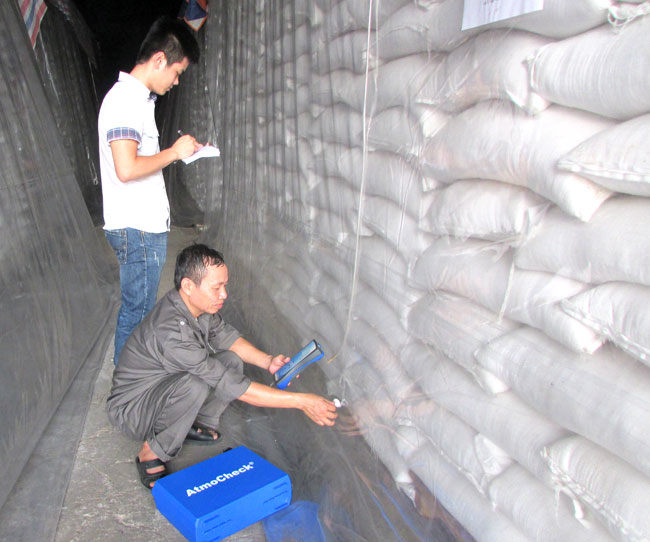Instruction 02 on Methods for Preserving National Reserve Rice
This content is detailed in Circular 78/2019/TT-BTC of the Ministry of Finance, stipulating the National Technical Regulations for nationally reserved rice.
Circular 78/2019/TT-BTC stipulates the following four methods for preserving national reserve rice:

Illustrative image (source: internet)
First, the airtight preservation method with N2 gas supplementation:
- N2 gas filling process
- Once the rice batch has been ensured to be airtight, proceed with the N2 gas filling
- Slowly fill the batch of rice with N2 gas. When the amount of gas filled reaches 0.6 kg N2/ton of rice, the membrane inflates, temporarily stop filling, wait for a period of time for N2 gas to permeate the rice, then check the concentration of N2 gas. If the N2 gas concentration is below 98%, continue to fill the remaining amount of gas according to the norm of 0.8 kg N2/ton of rice. If the concentration of gas does not meet 98%, check the airtightness of the rice batch.
Note that when preparing to fill the rice batch with gas, the air should be vacuumed about 5-7 times; right before filling, vacuum the air in the rice batch until the pressure gauge difference reaches 100mm. After filling the gas, check around the rice batch to detect any points of gas leakage.
- Measure and record the concentration of N2 gas after the gas filling (usually measure the gas concentration after 10-15 days to allow the gas to permeate the rice batch).
- Requirements for N2 gas concentration during the preservation process:
- The N2 concentration in the rice batch after filling must reach from 98% upwards, equivalent to N2 mass ranging from 0.7 kg to 0.8 kg N2/ton of rice; the rate of N2 concentration decrease in the rice batch mainly depends on the airtightness of the rice batch.
- When the N2 concentration drops below 98%, additional filling is needed to ensure it remains at ≥ 98%.
Second, the low-pressure preservation method:
In the case where the rice batch is stored while waiting for N2 gas supplementation and the batches of rice stored with N2 supplementation are not fully utilized and the storage time of the remaining quantity is less than 2 months, the low-pressure preservation method is applied.
- Once the rice batch is inspected and ensured to be airtight, proceed to vacuum the gas until the pressure gauge water column difference is 100 mm (negative pressure 980.7 Pa). When the pressure in the rice batch drops to the pressure gauge water column difference of 10 mm (negative pressure 98 Pa), continue vacuuming as above.
- Consistently maintain the pressure gauge water column difference at 10 mm (minimum negative pressure in the rice batch of 98 Pa) and monitor and record the pressure gauge's readings. If the pressure gauge water column returns to a balanced position before 24 hours, inspect and fix the leaks to find the gap or gas leaks.
- Only vacuum at the time of dry weather (relative humidity of the air is less than 80%).
- Monitor and record the temperature and relative humidity fluctuations inside the rice batch and the external environment weekly and monthly.
Refer to additional related regulations in Circular 78/2019/TT-BTC which takes effect from January 1, 2020.
Wednesday
- Number of deputy directors of departments in Vietnam in accordance with Decree 45/2025/ND-CP
- Cases ineligible for pardon in Vietnam in 2025
- Decree 50/2025 amending Decree 151/2017 on the management of public assets in Vietnam
- Circular 07/2025 amending Circular 02/2022 on the Law on Environmental Protection in Vietnam
- Adjustment to the organizational structure of the Ministry of Health of Vietnam: Certain agencies are no longer listed in the organizational structure
- Vietnam aims to welcome 22-23 million international tourists in Vietnam in 2025
-

- Notable new policies of Vietnam effective as of ...
- 16:26, 11/04/2025
-
.Medium.png)
- Notable documents of Vietnam in the previous week ...
- 16:21, 11/04/2025
-
.Medium.png)
- Notable documents of Vietnam in the previous week ...
- 16:11, 02/04/2025
-
.Medium.png)
- Notable new policies of Vietnam to be effective ...
- 16:04, 02/04/2025
-
.Medium.png)
- Notable new policies of Vietnam effective from ...
- 14:51, 21/03/2025
 Article table of contents
Article table of contents
